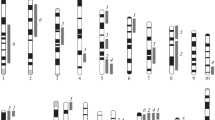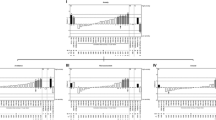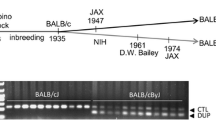Abstract
By performing a whole genome screen in an F2 intercross of two strains of mice (A/J and C57BL/6J), which differ markedly in their behavioral response to a brightly lit open field (O-F), we have mapped several quantitative trait loci (QTL) for this complex behavioral phenotype. QTL on chromosomes 1 and 10 were identified that affect both initial ambulation in the O-F (initial “response to novelty” ambulation) (lod of 7.1 and 8.8, respectively) and vertical rearings (lod of 4.5 and 8.5, respectively). For habituated O-F behavior, QTL were identified on chromosomes 3 and 10 for ambulation (lod of 4.1 and 14.7, respectively) and on chromosomes 1, 10, and 19 for vertical rearings (lod of 5.8, 6.0, and 4.7, respectively). The QTL on chromosome 1 (near D1Mit1 16; 101 cM) was specific for initial O-F ambulation behavior, whereas the QTL on chromosome 10 (near D10Mit237; 74 cM) affected both initial and habituated rearing behavior. Additional suggestive QTL (lod, >2.8) were mapped to chromosomes 1, 8, 11, 15, and 19. The QTL on chromosomes 1, 10, and 19 individually explain from 3.2 to 12.7%. Collectively, the multiple independent QTL explain from 16.3 to 24.1% of the F2 population's phe-notypic variance, depending on the trait. These identified QTL should prove useful for dissecting the genetic and behavioral dimensions of O-F behavior, fostering an understanding of individual differences.
Similar content being viewed by others
REFERENCES
Archer, J. (1973). Tests for emotionality in rats and mice: A review. Anim. Behav. 21:205–235.
Bates, J. E., Wachs, T. D., and VandenBos, G. R. (1995). Trends in research on temperament. Psychiatr. Serv. 46:661–663.
Belknap, J. K., Mitchell, S. R., O'Toole, L. A., Helms, M. L., and Crabbe, J. C. (1996). Type I and type II error rates for quantitative trait loci (QTL) mapping studies using recombinant inbred mouse strains. Behav. Genet. 26:149–160.
Belzung, C. (1992). Hippocampal mossy fibres: implication in novelty reactions or in anxiety behaviours? Behav. Brain Res. 51:149–155.
Berry, R. J., and Bronson, F. H. (1992). Life history and bioeconomy of the house mouse. Biol. Rev. 67:519–550.
Bisaga, A., and Kostowski, W. (1993). Individual behavioral differences and ethanol consumption in Wistar rats. Physiol. Behav. 54:1125–1131.
Blackson, T. C. (1994). Temperament: A salient correlate of risk factors for alcohol and drug abuse. Drug Alcohol Depend. 36:205–214.
Bouchard, T. J. (1994). Genes, environment, and personality. Science 264:1700–1701.
Broadhurst, P. L. (1960). Experiments in psychogenetics: Applications of biometrical genetics to the inheritance of behavior. In Eysenck, H. J. (ed.), Experiments in Personality, Routledge & Kegan Paul, London, Vol. 1, pp. 3–102.
Cerbone, A., and Sadile, A. G. (1994). Behavioral habituation to spatial novelty: Interference and noninterference studies. Neurosci. Biobehav. Rev. 18:497–518.
Cerbone, A., Patacchioli, F. R., and Sadile, A. G. (1993). A neurogenetic and morphogenetic approach to hippocampal functions based on individual differences and neurobehavioral covariations. Behav. Brain Res. 55:1–16.
Cloninger, C. R., Svrakic, D. M., and Przybeck, T. R. (1993). A psychobiological model of temperament and character. Arch. Gen. Psychiatry 50:975–990.
Cohen, R. A. (1993). The Neuropsychology of Attention, Plenum Press, New York.
Crawley, J. N. (1981). Neuropharmacologic specificity of a simple animal model for the behavioral actions of benzodiazepines. Pharmacol. Biochem. Behav. 15:695–699.
Crawley, J., and Goodwin, F. K. (1980). Preliminary report of a simple animal behavior model for the anxiolytic effects of benzodiazepines. Pharmacol. Biochem. Behav. 13:167–170.
Crusio, W. E., Schwegler, H., Brust, I., and van Abeelen, J. H. (1989a). Genetic selection for novelty-induced rearing behavior in mice produces changes in hippocampal mossy fiber distributions. J. Neurogenet. 5:87–93.
Crusio, W. E., Schwegler, H., and van Abeelen, J. H. (1989b). Behavioral responses to novelty and structural variation of the hippocampus in mice. I. Quantitative-genetic analysis of behavior in the open-field. Behav. Brain Res. 32:75–80.
Crusio, W. E., Schwegler, H., and van Abeelen, J. H., (1989c). Behavioral responses to novelty and structural variation of the hippocampus in mice. II. Multivariate genetic analysis. Behav. Brain Res. 32:81–88.
DeFries, J. C. (1969). Pleiotropic effects of albinism on open field behaviour in mice. Nature 221:65–66.
DeFries, J. C., and Hegmann, J. P. (1970). Genetic analysis of open-field behavior. In Lindzey, G., and Thiessen, D. D. (eds.), Contributions to Behavior-Genetic Analysis: The Mouse as a Prototype, Appleton-Century-Crofts, New York, pp. 23–56.
DeFries, J. C., Hegmann, J. P., and Halcomb, R. A. (1974). Response to 20 generations of selection for open-field activity in mice. Behav. Biol. 11:481–495.
Dietrich, W., Katz, H., Lincoln, S. E., Shin, H. S., Friedman, J., Dracopoli, N. C., and Lander, E. S. (1992). A genetic map of the mouse suitable for typing intraspecific crosses. Genetics 131:423–447.
Elston, R. C. (1994). P values, power and pitfalls in the linkage analysis of psychiatric disorders. In Gershon, E. R., and Cloninger, C. R. (eds.) Genetic Approaches to Mental Disorders, American Psychiatric Press, Washington, CD, pp. 3–21.
Farenberg, J. (1992). Psychophysiology of neuroticism and anxiety. In Gale, A., and Eysenck, M. W. (eds.), Handbook of Individual Differences: Biological Perspectives, John Wiley & Sons, Chichester.
Flint, J., Corley, R., DeFries, J. C., Fulker, D. W., Gray, J. A., Miller, S., and Collins, A. C. (1995). A simple genetic basis for a complex psychological trait in laboratory mice. Science 269:1432–1435.
Frankel, W. N., Johnson, E. W., and Lutz, C. M. (1995a). Congenic strains reveal effects of the epilepsy quantitative trait locus, E12, separate from other El loci. Mamm. Genome 6:839–843.
Frankel, W. N., Valenzuela, A., Lutz, C. M., Johnson, E. W., Dietrich, W. F., and Coffin, J. M. (1995b). New seizure frequency Qtl and the complex genetics of epilepsy in El mice. Mamm. Genome 6:830–838.
Fuller, J. L. (1967). Effects of the albino gene upon behaviour of mice. Anim. Behav. 15:467–470. ei]Gershon, E. S., and Cloninger, C. R. (eds.) (1994). Genetic Approaches to Mental Disorders, American Psychopathological Association Series, American Psychiatric Press, Washington, DC.
Glickman, S. E., and Morrison, B. J. (1969). Some behavioral and neural correlates of predation susceptibility in mice. Commun. Behav. Biol. 4:261–267.
Gonzalez, J. J. (1994). Neuropsychology of temperament. In Vernon, P. D. (ed.), The Neuropsychology of Individual Differences, Academic Press, San Diego, pp. 235–256.
Gray, J. A. (1987). The Psychology of Fear and Stress, Cambridge University Press, Cambridge.
Hall, C. S. (1938). The inheritance of emotionality. Sigma Xi Q. 26:17–27.
Hausheer-Zarmakupi, Z., Wolfer, D. P., Leisinger-Trigona, M-C., and Lipp, H. P. (1996). Selective breeding for extremes in open-field activity of mice entails a differentiation of hippocampal mossy fibers. Behav. Genet. 26:167–176.
Jacob, H. J., Lindpaintner, K., Lincoln, S. E., Kusumi, K., Bunker, R. K., Mao, Y. P., Ganten, D., Dzau, V. J., and Lander, E. S. (1991). Genetic mapping of a gene causing hypertension in the stroke-prone spontaneously hypertensive rat. Cell 67:213–224.
Kagan, J., Reznick, J. S., and Snidman, N. (1988). Biological bases of childhood shyness. Science 240:167–171.
Lander, E., and Kruglyak, L. (1995). Genetic dissection of complex traits—Guidelines for interpreting and reporting linkage results. Nat. Genet. 11:241–247.
Lander, E. S., Green, P., Abrahamson, J., Barlow, A., Daley, M., Lincoln, S., and Newburg, L. (1987). MAPMAKER: An interactive package for constructing primary genetic linkage maps of experimental and natural populations. Genomics 1:174–181.
Lassalle, J. M., Halley, H., and Roullet, P. (1994). Analysis of behavioral and hippocampal variation in congenic albino and pigmented B ALB mice. Behav. Genet. 24:161–169.
Lat, J. (1972). The analysis of habituation. Acta Neurobiol. Exp. 33:771–789.
Lincoln, S., and Lander, E. S. (1992). Systematic detection of errors in genetic linkage data. Genomics 14:604–610.
Mathis, C., Paul, S. M., and Crawley, J. N. (1994). Characterization of benzodiazepine-sensitive behaviors in the A/J and C57BL/6J inbred strains of mice. Behav. Genet. 24:171–180.
Mathis, C., Neumann, P. E., Gershenfeld, H., Paul, S. M., and Crawley, J. N. (1995). Analysis of anxiety-related behaviors and responses to benzodiazepine-related drugs in A × B and B × A recombinant inbred mouse strains. Behav. Genet. 25:557–568.
McCleam, G. E. (1959). The genetics of mouse behavior in novel situations. J. Comp. Physiol. Psychol. 52:62–67.
McInnes, L. A., and Freimer, N. B. (1995). Mapping genes for psychiatric disorders and behavioral traits. Curr. Opin. Genet. Dev. 5:376–381.
Neumann, P. E., Frankel, W. N., Letts, V. A., Coffin, J. M., Copp, A. J., and Bernfield, M. (1994). Multifactorial inheritance of neural tube defects: Localization of the major gene and recognition of modifiers in ct mutant mice. Nat. Genet. 6:357–362.
Ossenkopp, K. P., and Mazmanian, D. S. (1985). The measurement and integration of behavioral variables: Aggregation and complexity as important issues. Neurobehav. Toxicol. Teratol. 7:95–100.
Ossenkopp, K. P., Macrae, L. K., and Teskey, G. C. (1987). Automated multivariate measurement of spontaneous motor activity in mice: Time course and reliabilities of the behavioral measures. Pharmacol. Biochem. Behav. 27:565–568.
Paterson, A. H., Damon, S., Hewitt, J. D., Zamir, D., Rabinowitch, H. D., Lincoln, S. E., Lander, E. S., and Tanksley, S. D. (1991). Mendelian factors underlying quantitative traits in tomato: Comparison across species, generations, and environments. Genetics 127:181–197.
Piazza, P. V., Deminiere, J. M., Le, M. M., and Simon, H. (1989). Factors that predict individual vulnerability to amphetamine self-administration. Science 245:1511–1513.
Plomin, R., Owen, M. J., and McGuffin, P. (1994). The genetic basis of complex human behaviors. Science 264:1733–1739.
Risch, N., and Botstein, D. (1996). A manic depressive history. Nat. Genet. 12:351–353.
Simmel, E. C., and Bagwell, M. (1983). Genetics of exploratory behavior and activity. In Fuller, J. L., and Simmel, E. C. (eds.), Behavior Genetics: Principles and Applications, Lawrence Erlbaum, Hillsdale, NJ, pp. 89–115.
Smith, R. H., and Connor, J. L. (1974). The inheritance of behavioral wildness in house mice. Anim. Learn. Behav. 2:249–258.
Sokal, R. R., and Rohlf, F. J. (1995). Biometry, W. H. Freeman, New York.
Southwick, C. H., and Clark, L. H. (1966). Aggressive behavior and exploratory activity in fourteen mouse strains. Am. Zool. 6:559.
Stone, C. P. (1932). Wildness and savageness in rats of different strains. In Lashley, K. S. (ed.), Studies in the Dynamics of Behavior, University of Chicago Press, Chicago, pp. 1–55.
Streng, J. (1974). Exploration and learning behavior in mice selectively bred for high and low levels of activity. Behav. Genet. 4:191–204.
Suarez, S. D., and Gallup, G. G. (1982). Open-field behavior in chickens: The experimenter is a predator. J. Comp. Physiol. Psych. 96:432–439.
Tarter, R. E., and Vanyukoy, M. (1994). Alcoholism: A developmental disorder. J. Consult. Clin. Psychol. 62:1096–1107.
Thompson, W. R. (1956). The inheritance of behavior: Activity differences in five inbred mouse strains. J. Hered. 47:147–148.
Thompson, W. R. (1957). Traits, factors, and genes. Eugen. Q. 4:8–16.
Turunen, M. (1988). Trends in temperament research. Acta Paediatr. 7:81–86.
van Abeelen, J. H. (1975). Genetic analysis of behavioural responses to novelty in mice. Nature 254:239–241.
van Abeelen, J. H. (1989). Genetic control of hippocampal cholinergic and dynorphinergic mechanisms regulating novelty-induced exploratory behavior in house mice. Experientia 45:839–845.
Walsh, R. N., and Cummins, R. A. (1976). The open-field test: A critical review. Psychol. Bull. 83:482–504.
Watson, D., Clark, L. A., and Harkness, A. R. (1994). Structures of personality and their relevance to psychopathology. J. Abnorm. Psychol. 103:18–31.
Wills, T. A., DuHamel, K., and Vaccaro, D. (1995). Activity and mood temperament as predictors of adolescent substance use: Test of a self-regulation mediational model. J. Pers. Soc. Psychol. 68:901–916.
Author information
Authors and Affiliations
Rights and permissions
About this article
Cite this article
Gershenfeld, H.K., Neumann, P.E., Mathis, C. et al. Mapping Quantitative Trait Loci for Open-Field Behavior in Mice. Behav Genet 27, 201–210 (1997). https://doi.org/10.1023/A:1025653812535
Issue Date:
DOI: https://doi.org/10.1023/A:1025653812535




